What Was the Art and Architechture in Ancient Egypt Like Pre 1500
The history of ancient Arab republic of egypt was not one long, continuous journey of a unmarried civilization, merely rather one that was full of changes and turmoil. The story of the state has been divided into various periods by scholars. The same applies to Egyptian architecture. It did not consist of ane single style, merely rather a multitude of styles that all evolved in their own eras, all while having certain mutual characteristics.
Table of Contents
- 1 Aboriginal Egyptian Architecture
- ane.1 Characteristics of Ancient Egyptian Compages
- ane.2 Columns of Aboriginal Egyptian Architecture
- 2 Egyptian Monuments and Buildings
- 2.1 The Pyramids of Giza Complex (2580 BCE)
- 2.2 Luxor Temple (1400 BCE)
- 2.3 Temple of Karnak (2000 – 1700 BCE)
- 2.4 Ramesseum (c. 13th century BCE)
- 2.5 The Temple of Malkata (c. 14th century BCE)
- 2.6 Abu Simbel Temples (1264 BCE)
- 3 Ancient Egyptian Fortresses
- 3.1 Pelusium Fortress (yard to 800 BC)
- iii.two Fortress of Jaffa (c. 1460 to 1125 B.C.East)
- 4 Other Types of Egyptian Architecture
- four.1 Mastabas
- 4.2 Gardens
- 5 Frequently Asked Questions:
- 5.one What Were Pyramid Buildings and Egyptian Buildings Made From?
- 5.2 What Are the Most Well-Known Buildings of Egyptian Architecture?
Ancient Egyptian Architecture
The nearly iconic architecture to exist plant in the region must surely be the pyramid buildings, but there are many other Egyptian monuments that also deserve attention such as tombs, temples, fortresses, and palaces. Egyptian buildings were synthetic from limestone and mud bricks, which had been locally sourced.
Awe-inspiring architecture employed the construction technique known as "post and lintel", in which massive vertical structures hold up huge horizontal structures. For the Egyptians, it was important that their buildings were in alignment with certain astronomical bodies. The columns used in Egyptian buildings were near often busy in a style that mimicked the look of plants that the Egyptians held in high regard, such as the papyrus plant.
The artful of aboriginal Egyptian compages would surface in other areas of the globe over time, such as during the Orientalizing period and so in one case over again during the period known as Egyptomania in the 19th century.
Characteristics of Ancient Egyptian Architecture
Forest was non an easily accessible edifice material in ancient Arab republic of egypt, and so bricks made from baked mud and stone were the most mutual materials used. Limestone was pop, likewise as granite and sandstone. Bricks were usually used for town buildings and fortresses, while stone was used more often than not exclusively for temples and tombs.
The inside of the pyramid buildings was synthetic from rock sourced from local quarries likewise equally gravel, sand, and mud bricks. The outer shells of the Egyptian monuments were constructed from stone that had to be brought from distant regions such as Upper Egypt which was the source of red granite, and Tura, which was where the white limestone came from.
 A plan showing how the Pyramid of Khufu was built;Khoufou, CC BY-SA 3.0, via Wikimedia Commons
A plan showing how the Pyramid of Khufu was built;Khoufou, CC BY-SA 3.0, via Wikimedia Commons
Egyptian buildings and homes were synthetic from mud that had come from the Nile River's banks. The mud was and so poured into molds and dried in the blazing heat before beingness used for construction. The outside bricks would be highly chiseled and polished if they were intended for apply in a royal tomb, such as the pyramid buildings.
Many of these Egyptian settlements take now vanished because they were synthetic in the Nile Valley's cultivated region and were drowned as the river bed gradually rose over millennia, or the mud bricks and sun-dried bricks with which they were congenital were used every bit fertilizer past peasants.
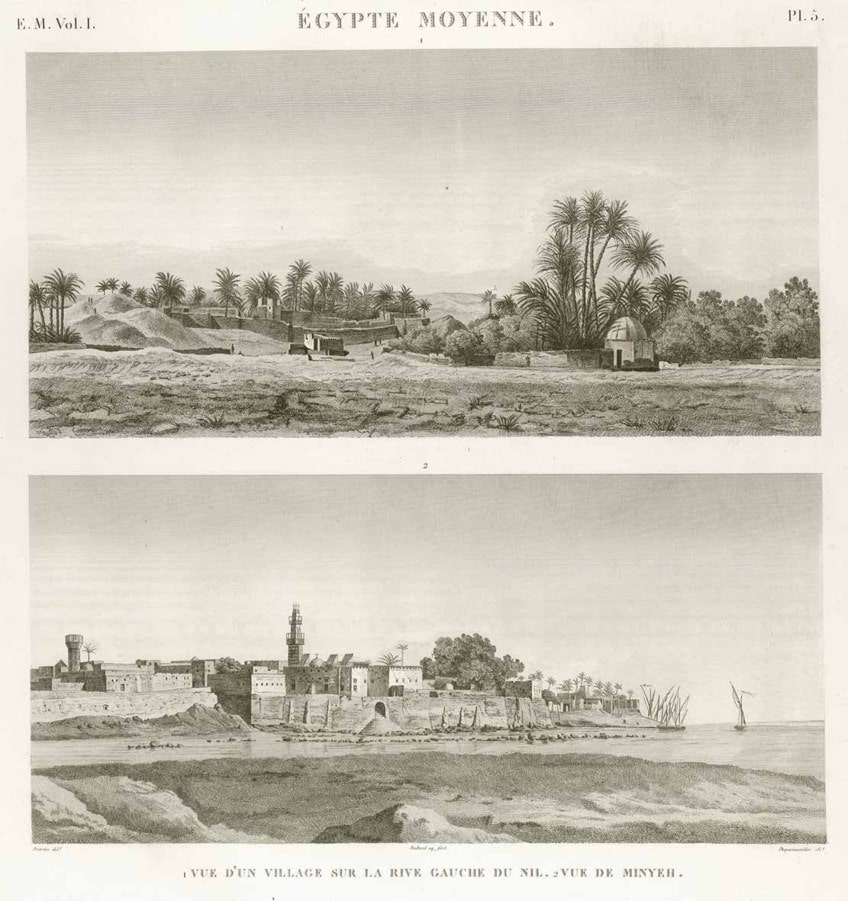 1: View of a village on the left of the bank of the Nile, ii: A view of the village of Al-Minya;Anonymous Unknown author, Public domain, via Wikimedia Commons
1: View of a village on the left of the bank of the Nile, ii: A view of the village of Al-Minya;Anonymous Unknown author, Public domain, via Wikimedia Commons
Other places cannot exist reached, and some accept disappeared due to the erection of new structures on top of the old ones. Due to the hot and dry climate of the region, yet, a few of these mud-brick buildings notwithstanding survive. This includes rare examples such every bit Buhen's fortresses, the town in Kahun from the Middle Kingdom, and the village of Deir al-Madinah.
Today, virtually of the surviving examples that we take of tombs and temples were those that were made of stone and were constructed on ground loftier enough not to exist affected by the flood of the Nile River.
Hence, most of what we know nigh aboriginal Egyptian architecture derives from the religious monumental architecture that was created in stone. The huge Egyptian monuments are typified by their sloped walls and sparse openings, which was most probable a technique carried through from building methods that provided some stability to mud structures. Information technology is also likely that the way of adorning surfaces in stone buildings was copied from the style in which mud walls were busy.
 Cartoon of a monolithic temple of Ancient Egypt as described by Herodotus, from the 1670 volume Turris Babel past Athanasius Kircher;Athanasius Kircher, Public domain, via Wikimedia Eatables
Cartoon of a monolithic temple of Ancient Egypt as described by Herodotus, from the 1670 volume Turris Babel past Athanasius Kircher;Athanasius Kircher, Public domain, via Wikimedia Eatables
Monumental architecture did not make utilize of the arch until the fourth dynasty, still, the post and lintel technique was used for back up force, with big external walls made from large stones and columns belongings up the apartment roofs.
Brilliantly colored hieroglyphic carvings and frescoes embrace nigh every surface of Egyptian monuments, both within and without, including the piers and columns. The Egyptians incorporated symbols that portrayed vultures, solar disks, scarabs, and other objects which were symbolic to them, such every bit flowers, plants, and leaves.
These not merely served a decorative purpose but as well a historical one, allowing events and incantations to exist recorded for prosperity.
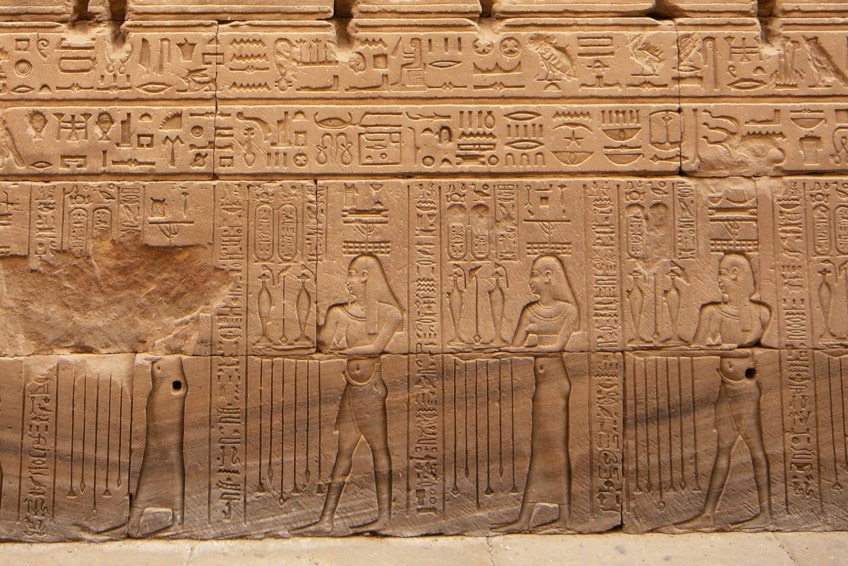 Hieroglyphic carvings on the walls of Edfu Temple; Edfu_Temple_032010_21.jpg: User:MatthiasKabelderivative work: JMCC1, CC Past-SA 3.0, via Wikimedia Commons
Hieroglyphic carvings on the walls of Edfu Temple; Edfu_Temple_032010_21.jpg: User:MatthiasKabelderivative work: JMCC1, CC Past-SA 3.0, via Wikimedia Commons
Due to these hieroglyphs, we today have a deeper insight into the life and times of the ancient Egyptian people. Ancient Egyptian architecture also reveals to the states that the people of ancient Arab republic of egypt had a keen understanding of astronomy, equally their buildings aligned with certain almanac events such as the equinoxes and solstices. The precision with which these calculations had to be fabricated also indicates a high level of mathematical understanding.
Columns of Ancient Egyptian Architecture
To mimic the organic shape of bundled reeds like palms, flowers, and reeds as old every bit 2600 BC, Egyptian architect Imhotep used etched stone columns. Intricate cylindrical shapes were also common in later Egyptian architecture. Their shape is believed to exist inspired past aboriginal reed-built sanctuaries.
The stone columns were ornately carved and painted with hieroglyphics, inscriptions, ritualistic iconography, and natural patterns.
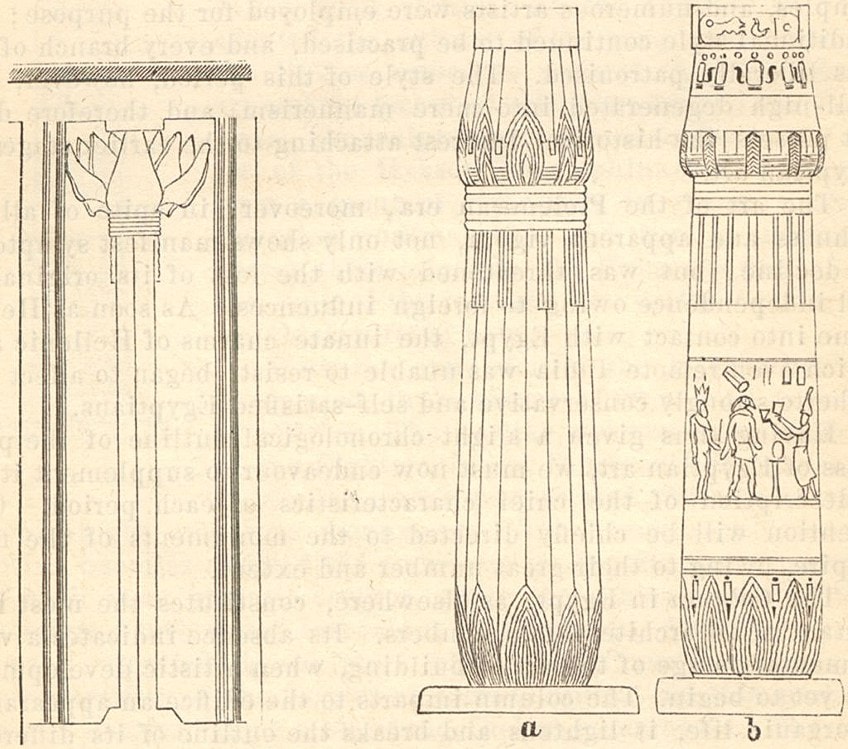 An 1885 line drawing of Aboriginal Egyptian papyriform columns; Unknown author Unknown author, CC Past-SA 2.5, via Wikimedia Commons
An 1885 line drawing of Aboriginal Egyptian papyriform columns; Unknown author Unknown author, CC Past-SA 2.5, via Wikimedia Commons
Papyriform columns are one of the most commonly found forms. The roots of the papyriform columns may be traced as far dorsum every bit the fifth Dynasty. They're fashioned out of lotus stems interwoven into bundles with bands. The capital, rather than extending out into a bellflower shape, at commencement will not bad outward and then narrow down similar a blossom. Stipules are a recurrent pattern on the base, which tapers to prefer the shape of a half-sphere, like a lily's stem.
The columns in the Luxor Temple are suggestive of papyrus bundles, probably symbolic of the marsh where the ancient Egyptians claimed the globe was created.
Egyptian Monuments and Buildings
The awe-inspiring architecture of Egypt is famous effectually the globe. This is mainly due to the iconic pyramids of Giza too as the Dandy Sphinx. However, in that location are many other examples of aboriginal Egyptian compages that also deserve attention for their accented beauty and architectural achievements.
The Pyramids of Giza Complex (2580 BCE)
| Location of Structure | Giza, Cairo, Egypt |
| Blazon of Structure | Monument |
| Period | Early Dynastic to Belatedly Period |
| Architects | Unknown (c. Early on Dynastic Period) |
The Giza Necropolis is situated about twenty kilometers from Cairo, on the Giza Plateau. The unabridged complex consists of the 3 large iconic pyramids, as well as several other smaller pyramids, around a hundred mastabas and chapels, and of course, the Corking Sphinx. The iconic pyramids date from the Quaternary Dynasty and stand as witness to the strength of the Pharaohs and the ability that their spiritual beliefs and ruling systems had on the ancient Egyptians. They were synthetic as both burying sites and as monuments by which their names could be immortalized.
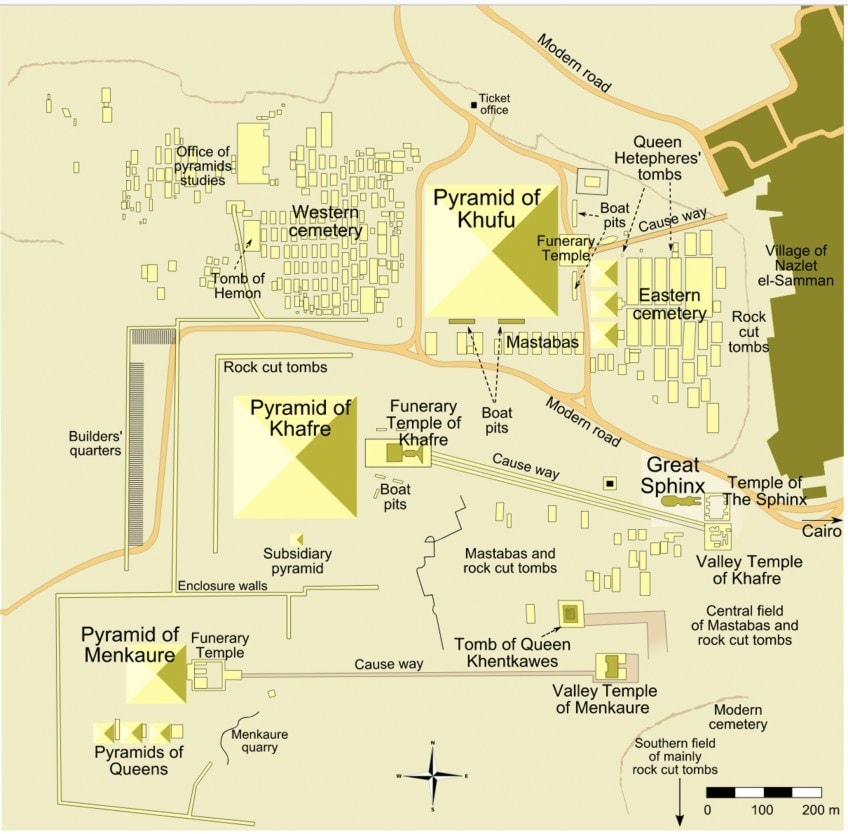 Map of the Giza Pyramid Circuitous;MesserWoland, CC BY-SA three.0, via Wikimedia Commons
Map of the Giza Pyramid Circuitous;MesserWoland, CC BY-SA three.0, via Wikimedia Commons
Egypt's outstanding degree of engineering science and design on a big scale is demonstrated by the massive size and straightforward shape of the buildings.
The Great Pyramid of Giza (too known as the Not bad Pyramid of Khafre or the Pyramid of Cheops), the biggest pyramid in the globe and the first building of the Giza pyramids, was built in 2580 BC and is the only remaining construction of the Ancient World's Wonders.
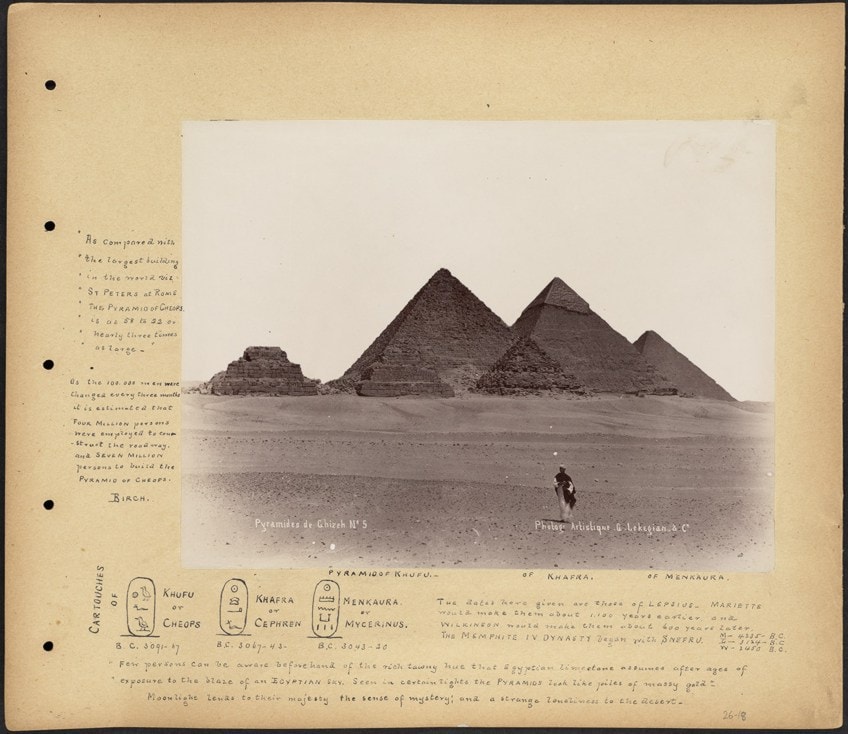 Scrapbook folio containing a photograph of a human standing in front of the Pyramids of Giza complex. The page likewise includes several quotes, drawings of cartouches, and information near the Egyptian dynasties;William Vaughn TupperFlickr uploader BPL, Public domain, via Wikimedia Eatables
Scrapbook folio containing a photograph of a human standing in front of the Pyramids of Giza complex. The page likewise includes several quotes, drawings of cartouches, and information near the Egyptian dynasties;William Vaughn TupperFlickr uploader BPL, Public domain, via Wikimedia Eatables
Khafre's Pyramid is estimated to have been finished virtually 2532 BCE, near the stop of Khafre's rule. Khafre was foresighted plenty to construct his pyramid side by side to his begetter's. Although it is not as loftier as his father'south pyramid, he was able to requite it the illusion of existence higher by constructing it on a site 10 meters higher in summit than the ane belonging to his father.
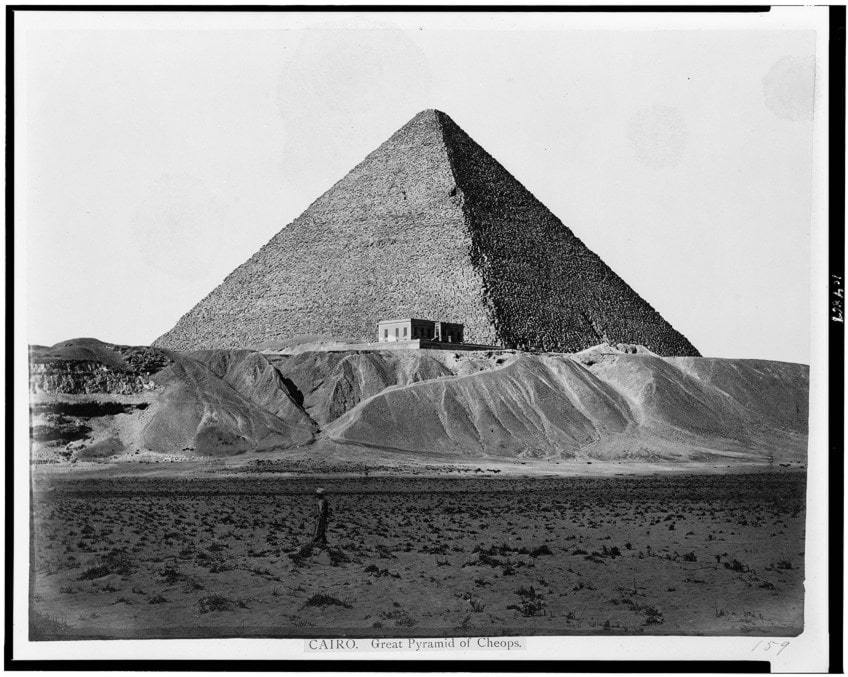 Great Pyramid of Cheops; Miscellaneous Items in High Demand, PPOC, Library of Congress, Public domain, via Wikimedia Eatables
Great Pyramid of Cheops; Miscellaneous Items in High Demand, PPOC, Library of Congress, Public domain, via Wikimedia Eatables
Chefren also commissioned the construction of a huge Sphinx to serve as a guardian over his grave, in addition to his pyramid. The ancient Greeks saw a human confront on a lion's body, probably a representation of the pharaoh, every bit a sign of divinity 1500 years later. The Great Sphinx reaches 20 meters tall and is sculpted out of limestone bedrock.
Archaeological evidence suggests that the Great Sphinx was congenital nether Pharaoh Khafre, the mastermind behind the second pyramid of Giza, around 2500 BC.
The trunk stones of the Sphinx were used to build a temple in front end of it, but neither the enclosure nor the temple were completed, and the scarcity of Old Kingdom cultural material implies that there was no Sphinx worship at the fourth dimension.
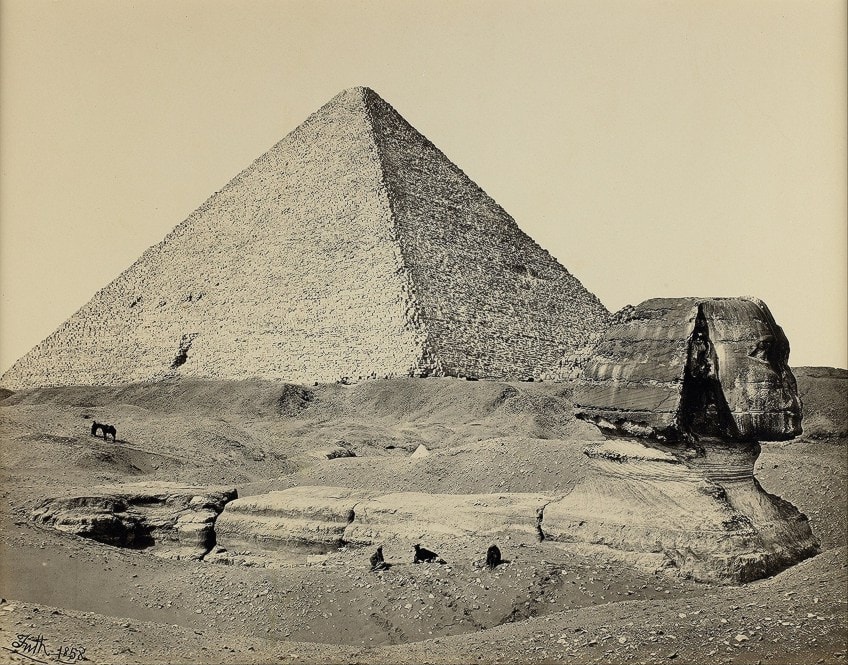 The Peachy Pyramid and the Great Sphinx, Arab republic of egypt; Francis Frith, Public domain, via Wikimedia Eatables
The Peachy Pyramid and the Great Sphinx, Arab republic of egypt; Francis Frith, Public domain, via Wikimedia Eatables
The northern boundary barrier of the Khafre Valley Temple was to be demolished in order to create the temple, indicating that the Khafre funerary complex existed prior to the Sphinx. The enclosure'southward south wall's angle and location further imply that the causeway linking Khafre'south Pyramid and Valley Temple stood before the Sphinx was constructed.
The Sphinx Temple'southward lower foundation level further suggests that it does not predate the Valley Temple.
It is believed that the Sphinx'south caput may have been sculpted first, out of yardang, or possibly a side of bedrock. These tin have on creature-like forms on rare occasions. El-Baz speculates that the ditch or moat effectually the Sphinx was quarried out later to allow for the completion of the sculpture's consummate body.
Menkaure'due south pyramid is the shortest of the Great Pyramids, at 65 meters tall and dating from around 2490 BC. Pyramids, according to common perception, are incredibly perplexing, with several tunnels within the pyramid to misfile tomb robbers. This isn't accurate. Pyramid shafts are often uncomplicated, leading directly to the tomb.
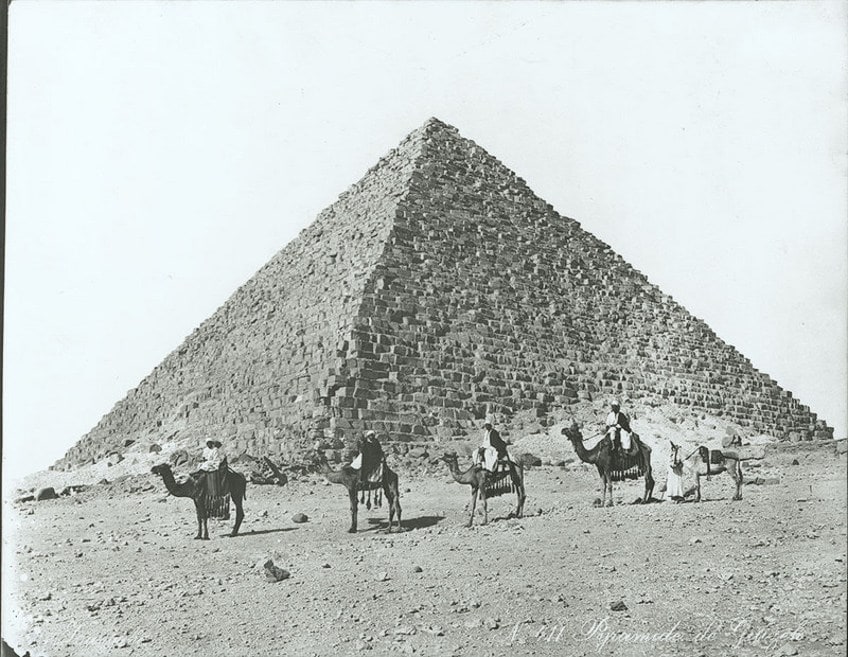 Pyramid of Menkaure; Zangaki, Public domain, via Wikimedia Commons
Pyramid of Menkaure; Zangaki, Public domain, via Wikimedia Commons
Because of the enormous calibration of the pyramids, thieves were drawn to the treasure that lay within, and tombs were looted adequately soon after they were sealed in certain instances. There are occasionally further tunnels, but they were built to aid the architects figure out how deep they could dig the tomb into the Earth's crust. Some other false popular belief is that successive royalty was laid to balance in the Valley of the Kings to keep their location hidden from looters.
In reality, pyramids were built for many more dynasties to come, albeit on a scale that was noticeably smaller than previously. In the end, it was various factors regarding their economic system that put an finish to pyramid structure and not thieves.
Luxor Temple (1400 BCE)
| Location of Construction | Luxor, Egypt |
| Type of Structure | Sanctuary |
| Period | 1400 BCE |
| Architects | Unknown (c. 1400 BCE) |
This massive temple complex is situated on the eastern depository financial institution of the Nile River in the ancient city of Thebes (modern-day Luxor). It was during Amenhotep III's reign in the 14th century BCE that work first began on the Egyptian buildings. Pharaohs such every bit Tutankhamun and Horemheb fabricated additions such as friezes, statues, and columns. After destroying all traces of the cartouches that mentioned his begetter, Akhenaten then created an altar to the Aten. The biggest addition to the monumental compages happened a century after the project first began when Egypt was ruled by Ramesses Ii.
This makes the Egyptian buildings at Luxor different from any other, as at that place were only two pharaohs noted by scholars as being involved in the architectural pattern.
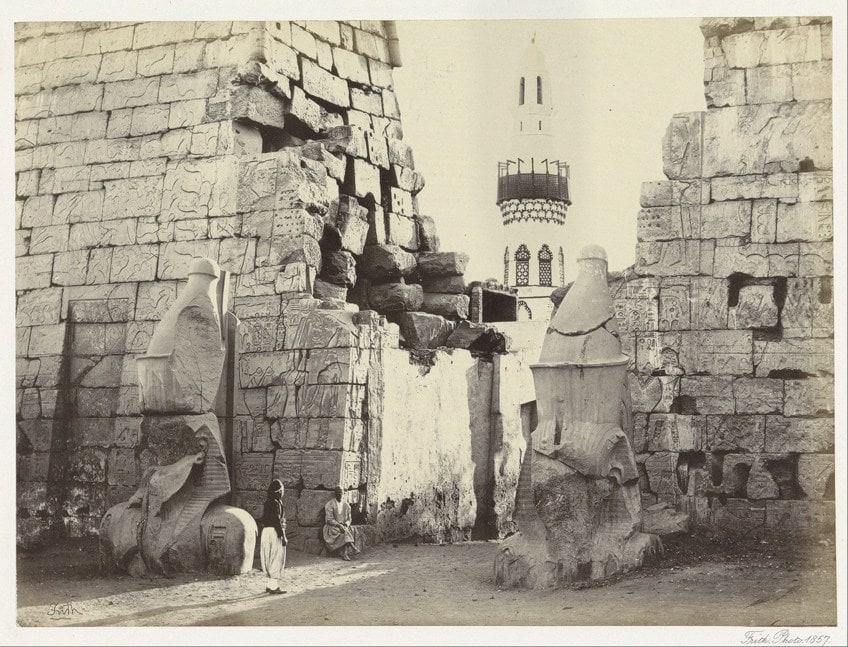 Entrance to the neat Luxor Temple; Rijksmuseum, CC0, via Wikimedia Eatables
Entrance to the neat Luxor Temple; Rijksmuseum, CC0, via Wikimedia Eatables
The temple complex starts with Ramesses II'south Outset Pylon, which is 24 meters tall. This pylon was adorned with images depicting Ramesses' war successes, such as the one in Qadesh, as well every bit those of succeeding pharaohs, specifically those of the Ethiopian Dynasty and Nubian dynasty. Vi huge sculptures of Ramesses lined the nifty temple circuitous's entrance, 4 of them sitting and two of them upright, only just two of those sitting have remained.
A 25-meter large granite obelisk may as well be seen by mod tourists; it was part of a pair until 1835 when the one was transported to Paris, where information technology is currently housed in the middle of the Place de la Concorde.
Ramesses Two also erected a peristyle courtyard, which is attainable by the pylon gateway. This section of the temple, likewise as the pylon, were constructed at an angle to the remainder of the temple, possibly to fit the three baroque shrines in the northwest corner, which were already at that place. The processional colonnade erected by Amenhotep Three follows the peristyle courtyard – a 100-meter hallway flanked past 14 papyrus-capital columns.
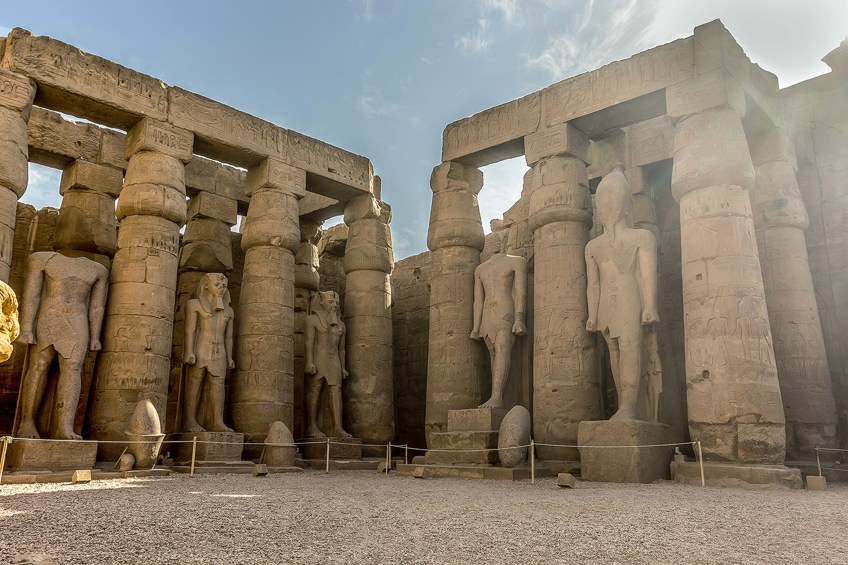 Courtyard of the Luxor Temple; Mahmoud Mostafa Ashour, CC Past-SA 4.0, via Wikimedia Commons
Courtyard of the Luxor Temple; Mahmoud Mostafa Ashour, CC Past-SA 4.0, via Wikimedia Commons
Friezes on the walls depict the many stages of the Opet Festival, starting with offerings at Karnak in the upper left and continuing throughout Amun'south entrance in Luxor at the finish of that wall, and concluding with his arrival on the other side. Tutankhamun installed the decorations: the young pharaoh is portrayed, simply his proper noun has been changed past Horemheb's.
The courtyard that extends beyond the colonnade was as well constructed by Amenhotep III. The easternmost columns have the finest preservation since they even so show some signs of their original hue. The 36-column hypostyle court on the southern side of the courtyard leads to the temple'due south gloomy interior.
Temple of Karnak (2000 – 1700 BCE)
| Location of Construction | El-Karnak, Egypt |
| Blazon of Structure | Sanctuary |
| Period | The Middle Kingdom to the Ptolemaic Kingdom |
| Architects | Unknown (2000 – 1700 BCE) |
Karnak's temple complex lies 2.5 kilometers north of Luxor on the banks of the Nile River. It is divided into quarters: the Precincts of Amon-Re, the Precincts of Montu, the Precincts of Mut, and the Temple of Amenhotep 4 (demolished), and as well a couple of minor shrines and protected areas outside the 4 main sections' enclosing walls, and many thoroughfares of sphinxes with Ram's heads. Several pharaohs accept added to and improved upon this temple complex. Notwithstanding, every New Kingdom emperor fabricated a substantial contribution to information technology.
There are obelisks, chapels, courtyards, halls, and other smaller temples scattered throughout the complex, which covers an area of more than 200 acres.
 Temple of Karnak complex;New York Public Library, No restrictions, via Wikimedia Commons
Temple of Karnak complex;New York Public Library, No restrictions, via Wikimedia Commons
With regard to Egyptian monuments and temples, Karnak stands out because of how long it was synthetic and utilized. Construction began in the 16th century BC on a small-scale calibration, but as many as twenty temples and chapels were erected in the main precinct alone throughout fourth dimension. The structures were built by effectually 30 pharaohs, allowing them to reach hitherto unimaginable sizes, intricacy, and diverseness.
Few of Karnak'due south features are unique, but the sheer scale and quantity of these features are phenomenal.
The temple of Amun-Re at Karnak is one of Egypt's most important examples of ancient Egyptian compages. This temple, similar many others in Arab republic of egypt, celebrates the gods and commemorates previous achievements, including thousands of years of history recorded by inscriptions on many of the walls and columns discovered on site, which were oft inverse or entirely obliterated and restored by subsequent rulers.
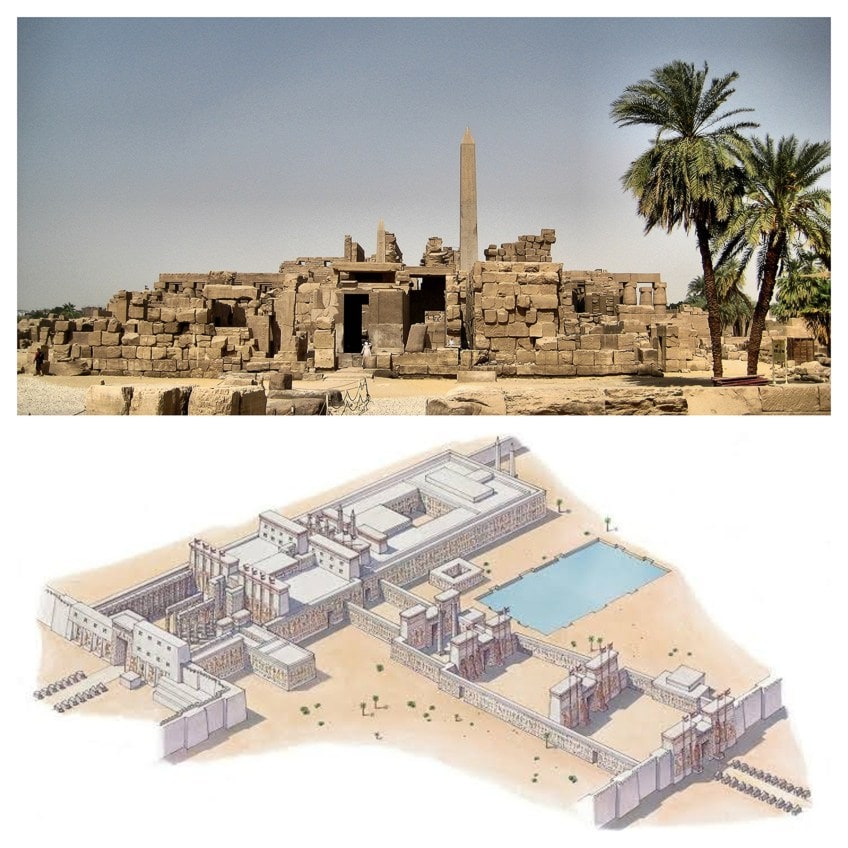 Acme: Ruins of the Karnak Temple of Amun-Re;Francisco Anzola, CC BY 2.0, via Wikimedia Commons | Bottom: Geometric model of Karnak Temple of Amun-Re in aboriginal times; حسني بن بارك, CC Past-SA four.0, via Wikimedia Commons
Acme: Ruins of the Karnak Temple of Amun-Re;Francisco Anzola, CC BY 2.0, via Wikimedia Commons | Bottom: Geometric model of Karnak Temple of Amun-Re in aboriginal times; حسني بن بارك, CC Past-SA four.0, via Wikimedia Commons
Amun-Re'south temple was built in thirds, the 3rd of which was built by the pharaohs of the New Kingdom. Numerous elements of the architecture, for example, the sanctuary of the circuitous, were in alignment with many astronomical events such as the summer solstice sunset, as was customary in Egyptian architecture.
I of the well-nigh impressive structures on the property is the 5,000-square-meter hall, synthetic during the Ramesside menstruation. This massive hall is supported by a hundred and thirty-nine columns made from mud brick and sandstone, including 12 center columns that were formerly lavishly adorned.
Ramesseum (c. 13th century BCE)
| Location of Structure | Luxor, Arab republic of egypt |
| Type of Structure | Sanctuary |
| Catamenia | 13th Century BCE |
| Architects | Unknown (c. 13th century BCE) |
From about 1279 to 1213 BCE, Ramesses Ii, a 19th Dynasty pharaoh, governed Arab republic of egypt. Among his numerous achievements, including as the extension of Egypt's frontiers, he congenital the Ramesseum, a huge temple at Thebes, the New Kingdom's capital at the time.
The Ramesseum was a cute temple with massive sculptures guarding the entrance.
A 62-foot statue of the pharaoh himself was the most striking feature of the pyramid. This amazing pharaonic statue'southward original mass and dimensions can only be estimated because of the fact that merely the base of operations and body remain. At least 1 delineation of Ramses' state of war successes, for example, the Battle of Kadesh and the pillaging of "Shalem," may be seen in reliefs found in the temple.
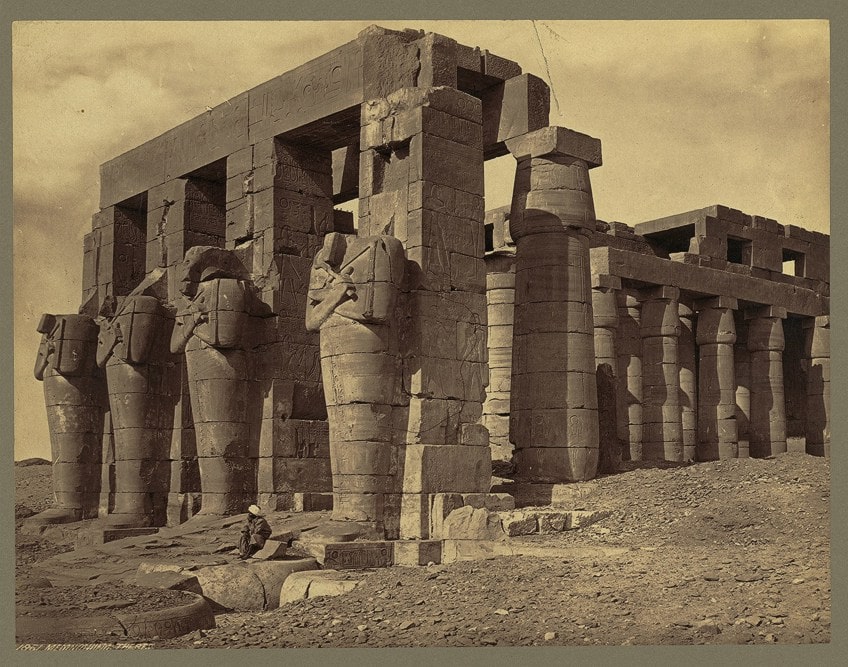 The Ramesseum; Good, Frank Mason, 1839-1928, photographer, Public domain, via Wikimedia Commons
The Ramesseum; Good, Frank Mason, 1839-1928, photographer, Public domain, via Wikimedia Commons
The Temple of Malkata (c. 14th century BCE)
| Location of Construction | Luxor, Egypt |
| Type of Structure | Palace Complex |
| Period | c. 14th century BCE |
| Architects | Unknown (c. 14th century BCE) |
More than than 250 structures and monuments were erected during Amenhotep Iii'due south reign. The ancient place of worship in Malkata, referred to as the "home of joy" past ancient Egyptians, was built to act as his royal dwelling house on the western banking concern of Thebes, to the southern side of the necropolis. Virtually 226,000 square meters of space are occupied here.
There are several buildings, courts, parade grounds, and dwellings on the huge site. It is thought to take served equally a town besides every bit a temple and a residence for the Pharaoh.
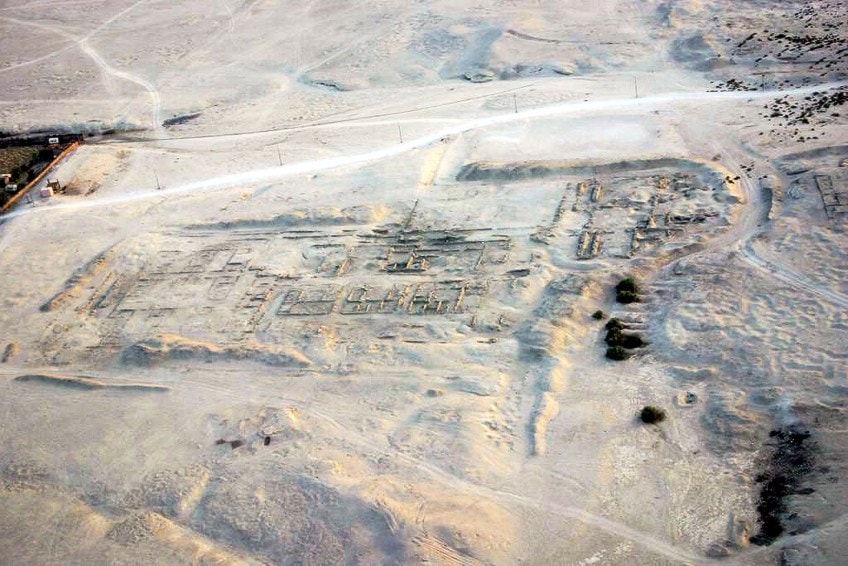 Palace of Malkata from the air;en:User:Markh, Public domain, via Wikimedia Commons
Palace of Malkata from the air;en:User:Markh, Public domain, via Wikimedia Commons
The Pharaoh's residences, which included a number of chambers and courts arranged effectually a columned dining hall, occupied the majority of the circuitous's eye. A huge throne room connected to smaller rooms, for storage, waiting, and smaller audiences, accompanied the apartments, which probable housed the regal company and overseas guests. In this part of the complex, the most important structures are the Western Villas, North Palace and Hamlet, and the Temple.
The exterior measurements of the temple are roughly 183.5 past 110.5 meters, and it is divided into two sections: the vast courtyard and the temple proper.
The huge frontcourt, which is oriented eastward-w and comprises the due east portion of the temple complex, measures 131.5 by 105.five meters. A modest retaining wall separates the western part of the court from the balance. The lower terrace has a foursquare shape, while the upper terrace has a rectangle shape. In the top one-half of the court, mud bricks were used to cover the surface and a ramp was enclosed by walls connecting the lower forecourt to the college landing.
The middle, north, and due south components of the temple may exist carve up into 3 split up sections.
A tiny rectangular anteroom (6.5 by 3.five m) marks the centre portion, and several of the door jambs, including the entrance hall, bear inscriptions such as "given lifelike Ra eternally." The entrance hall is followed by a 12.5 by 14.five-meter hall, which is accessed by a three.five-meter wide archway in the middle of the dividing panel. There is an indication that this chamber'southward ceiling was formerly painted with yellow stars on a blue backdrop, but today'south walls merely appear to be white stucco over mud plaster.
 Ceiling painting from Amenhotep Iii's Palace of Malkata, c. 1390-11353 BC;Metropolitan Museum of Fine art, CC0, via Wikimedia Commons
Ceiling painting from Amenhotep Iii's Palace of Malkata, c. 1390-11353 BC;Metropolitan Museum of Fine art, CC0, via Wikimedia Commons
In low-cal of the numerous decorative plaster fragments plant in the room'south deposit, we may assume that these were ornately decorated as well. The ceiling is supported by six columns bundled in two rows, east-westward. At that place are just a few fragments of the column bases left, but they suggest that the columns had a diameter of about 2.25 yard. The columns are ii.5 meters away from the walls, and each row is effectually one.4 meters apart, with a 3-meter space betwixt them.
The second hall may exist accessed through a three-meter-wide entrance in the center of the first hall'south rear wall.
The second hall is comparable to the beginning in that its ceiling is adorned with patterns and pictures that are similar, if not identical, to the first. As with the first hall'south ceiling, the second hall columns prop upward the ceiling, four in all, arranged in two rows on the aforementioned axis as the first hall'southward, with a 3 thousand wide infinite between them. A minimum of one of the chambers in hall two seems to be in honor of the Maat religion, implying that the other three in this region may have as well had a religious part.
There are two parts to the southern half of the temple: western and southern. Six chambers make up the western role, but the southern one-half's size (19.5 by 17.two yard) implies it may accept acted as another open court. Blueish ceramic tiles with gilded inlays were seen along the edges in several of these rooms. The 10 chambers in the northern portion of the temple are similar in way to the ten in the southern part.
Bricks inscribed with different inscriptions, such as "the temple of Amun" or "Nebmaatre in the Temple of Amun" suggest the temple was devoted to the Egyptian god Amun. The firm of Rejoicing appears to have been built around the temple.
The temple of Malakata has many features in common with other New Kingdom cult temples, including grand halls and religiously themed chambers, merely many others are more like storerooms.
Abu Simbel Temples (1264 BCE)
| Location of Structure | Nubia, Egypt |
| Blazon of Construction | Temple |
| Period | 1264 BCE |
| Architects | Unknown (c 1264 BC) |
Abu Simbel is a pair of huge rock-cutting temples near the Sudanese border in the hamlet of Abu Simbel, Aswan Governorate, Upper Egypt. They're around 230 kilometers (140 miles) southwest of Aswan, on the western shore of Lake Nasser (about 300 km past road). The complex is part of the "Nubian Monuments" UNESCO World Heritage Site, which stretches from Abu Simbel to Philae (near Aswan) and includes Amada, Wadi es-Sebua, and other Nubian monuments.
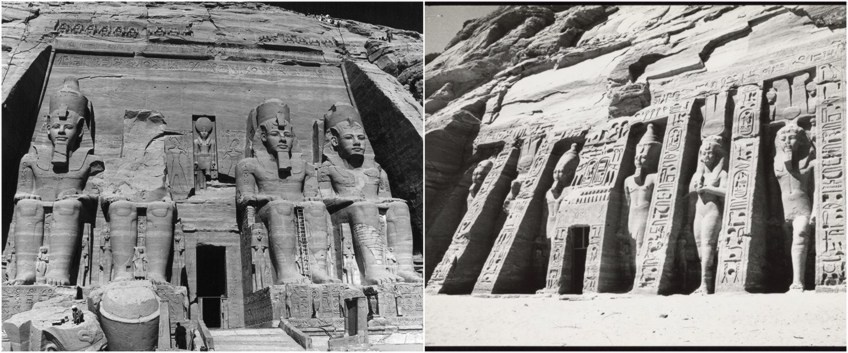 LEFT: Great Temple of Abu Simbel; UNESCO, CC By-SA 3.0 IGO, via Wikimedia Commons | RIGHT: Small Temple of Abu Simbel (Temple of Hathor); UNESCO / Roque Javier Laurenza, CC BY-SA iii.0 IGO, via Wikimedia Commons
LEFT: Great Temple of Abu Simbel; UNESCO, CC By-SA 3.0 IGO, via Wikimedia Commons | RIGHT: Small Temple of Abu Simbel (Temple of Hathor); UNESCO / Roque Javier Laurenza, CC BY-SA iii.0 IGO, via Wikimedia Commons
The twin temples were cutting out of the mountainside in the 13th century BC, during the reign of Pharaoh Ramesses Ii of the 19th Dynasty. They serve every bit a permanent memorial to King Ramesses II. His married woman Nefertari and children may be seen in tiny figurines nearly his feet, as they were accounted less of import and were not given the aforementioned size position. This is a tribute to his victory at the Battle of Kadesh.
Their massive exterior stone relief figures have get widely recognizable.
Ancient Egyptian Fortresses
The disharmonize betwixt opposing kingdoms prompted the construction of fortifications in Ancient Arab republic of egypt. Nearly all of the castles examined during this time period used the same materials. But a few Old Kingdom fortifications, like the fort of Buhen, used rock to build their walls. Mudbrick was used for the bulk of the walls, although they were strengthened with other materials including lumber.
In addition to the pavement, rocks were used to preclude erosion and maintain them. Secondary walls were synthetic outside of the main fortress walls and were close in proximity to one another. As a outcome, invaders would have difficulty since they would have to demolish this bulwark before they could approach the fort'due south main walls. If the opponent was able to get through the initial barrier, a different tactic was used. After reaching the main wall, a ditch would be dug between the secondary and showtime walls.
The goal was to put the adversary in a position where they would be exposed to enemy fire, leaving the invaders vulnerable to arrow burn.
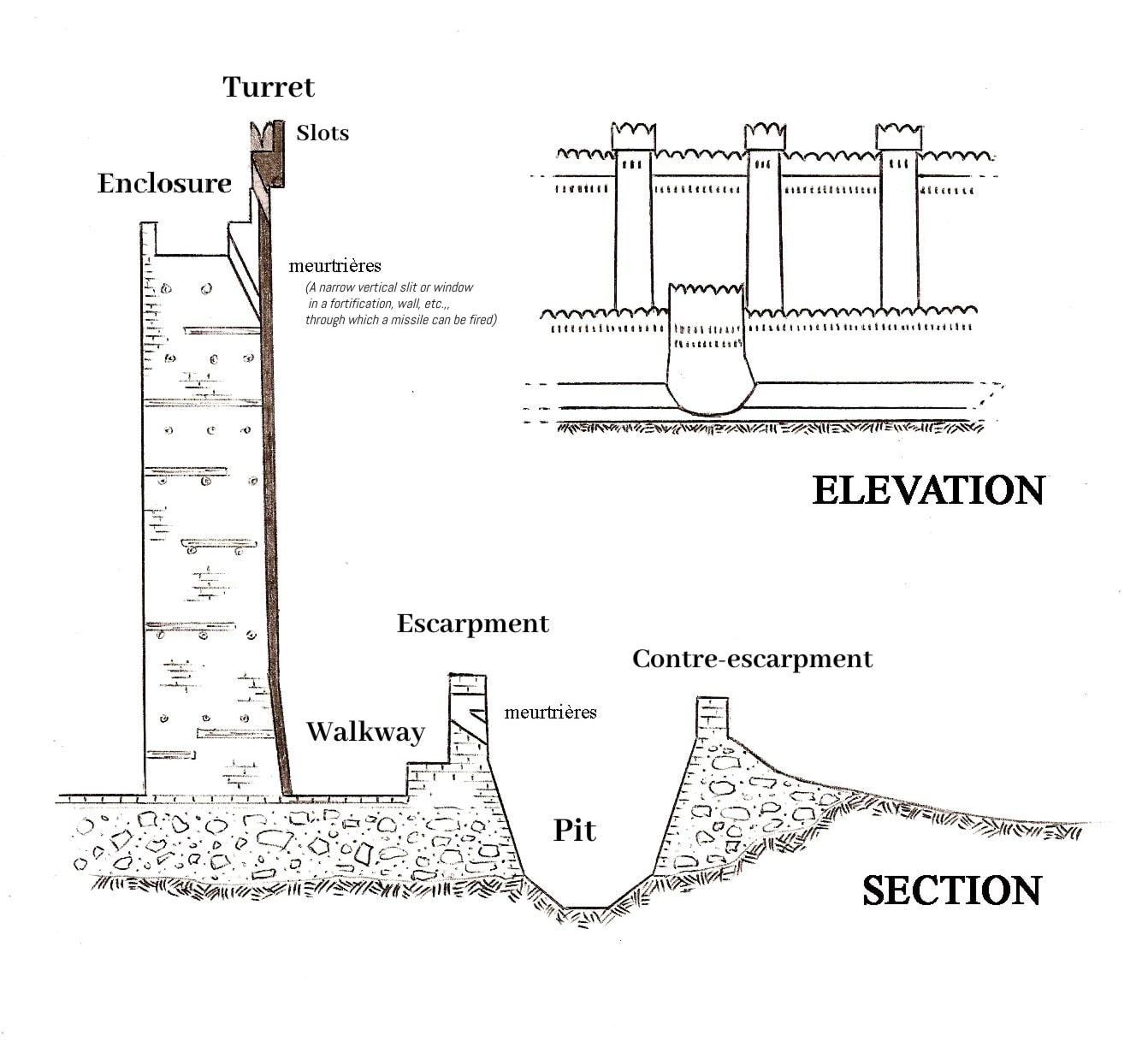 Fortification plan of an Egyptian Nubian fortress;MONNIER Franck, CC BY-SA 3.0, via Wikimedia Eatables
Fortification plan of an Egyptian Nubian fortress;MONNIER Franck, CC BY-SA 3.0, via Wikimedia Eatables
During periods of unification, the position of these ditch walls inside strongholds would become demilitarized, resulting in their demolition. The materials used to build the walls could subsequently exist recycled, making the whole concept highly cost-effective.
Ancient Egyptian fortifications served a diversity of purposes.
The 12th Dynasty of Egypt built fortified outposts along the Nubian River during the Middle Kingdom Menstruation to gain command of the region. Fortresses in Egypt did non always sit along the river. Sites in Egypt and Nubia would be situated on rocky or sandy terrain, respectively. Equally a result of this tactic, the organisation was able to expand its influence throughout the region while also discouraging competing organizations from conducting raids.
Pelusium Fortress (one thousand to 800 BC)
| Location of Structure | Nile Delta, Egypt |
| Type of Structure | Fortress |
| Catamenia | 1000 to 800 BC |
| Architects | Unknown (.1000 to 800 BCE) |
The Pelusium stronghold functioned as a defensive fortification confronting invaders approaching the Nile Delta. Pelusium was also recognized for being a commercial hub, and information technology performed this purpose for more than a millennium (both maritime and state). Egypt and the Levant were the primary trading partners. While in that location is no definite data on the fortress'due south construction, it is idea that Pelusium was congenital during the Middle Kingdom era or during the Saite and Persian periods in the 16th and 18th centuries.
Pelusium is as well perceived as a significant part of the Nile since more than remains have been unearthed exterior of its boundaries, indicating that the surface area was heavily inhabited.
 A drawing of a view beyond a largely empty arid landscape. To the left the remains of role of a fortress sit atop a small slope, looking out over a flat landscape all the way to the afar appearance of Pelusium; James McBey, Public domain, via Wikimedia Commons
A drawing of a view beyond a largely empty arid landscape. To the left the remains of role of a fortress sit atop a small slope, looking out over a flat landscape all the way to the afar appearance of Pelusium; James McBey, Public domain, via Wikimedia Commons
The architectural features of Pelusium (such every bit its towers and gates) appear to exist constructed of limestone. A rising industry in metal is also supposed to have been in this expanse as a result of the discovery of copper ore. During excavations at the site, older materials going back to some of the early dynasties were too discovered.
Materials constitute include basalt, granite, diorite, marble, and quartzite. Because the stronghold was built so almost to the Nile River, it was encircled by both dunes and coastal lines.
 A 15th-century miniature painting depicting the flight of Dirgham at Pelusium;Unknown writer Unknown writer, Public domain, via Wikimedia Commons
A 15th-century miniature painting depicting the flight of Dirgham at Pelusium;Unknown writer Unknown writer, Public domain, via Wikimedia Commons
The decline of the Pelusium stronghold was caused by a variety of factors. During the period of its heyday, the Bubonic Plague first emerged in the Mediterranean region, and several fires broke out in the stronghold. Conquest by the Persians, as well as a reject in commerce, might perchance be related to the ascent, which could have resulted in an increase in desertion.
Officially, natural causes such as tectonic movements caused Pelusium to disintegrate. The site's formal abandonment is dated to the time of the Crusades.
Fortress of Jaffa (c. 1460 to 1125 B.C.E)
| Location of Structure | Tel Yafo, ancient Yapu |
| Type of Structure | Fortress |
| Period | c. 1460 to 1125 B.C.E |
| Architects | Unknown (c. 1460 to 1125 B.C.East) |
During Egypt'southward New Kingdom period, Jaffa Fortress was significant. It functioned as a fortification too every bit the Mediterranean coast's port. Jaffa is withal an important Egyptian port today. The location was formerly under the sovereignty of the Canaanites before falling under the rule of the Egyptian Empire.
It is unknown what exactly triggered the transition from Canaanite to Egyptian occupation due to a paucity of show. The fortress was effective in containing the campaigns from Pharaohs of the 18th dynasty during the Late Bronze Historic period.
 The Fortress of Jaffa; Auguste Salzmann, CC0, via Wikimedia Commons
The Fortress of Jaffa; Auguste Salzmann, CC0, via Wikimedia Commons
In terms of functionality, the site served several purposes. According to legend, the fortress' principal role was to serve as a storehouse for the army of Egypt.
Rameses gate, which dates from the Late Bronze Age, connects to the fortress. Along with the fortress, ramparts were unearthed. Upon excavation, the site included several artifacts like bowls, imported jars, pot stands, beer, and bread, emphasizing the significance of these goods to the surface area. The finding of these artifacts demonstrates a strong relationship between food storage and the manufacture of ceramic things.
Other Types of Egyptian Architecture
We take covered the massive pop Egyptian structures up to at present. However, the Egyptians built many types of structures that were of import in their lives. At present we volition wait at the burial tombs and ancient gardens of the Egyptians.
Mastabas
Mastabas are royally significant burying tombs. Many of the tombs discovered throughout history were chosen by Egyptian kings to be situated near the Nile River. The structural outside of Mastabas has inverse over fourth dimension, although in that location has been a visible progression during the elapsing of Egyptian dynasties. The First Egyptian Dynasty's mastabas would be built of stepped bricks. By the Fourth Dynasty, the pattern had evolved equally the structural outside changed from brick to rock.
The motivation behind mastabas' stepped designs is linked to the concept of "accretion."
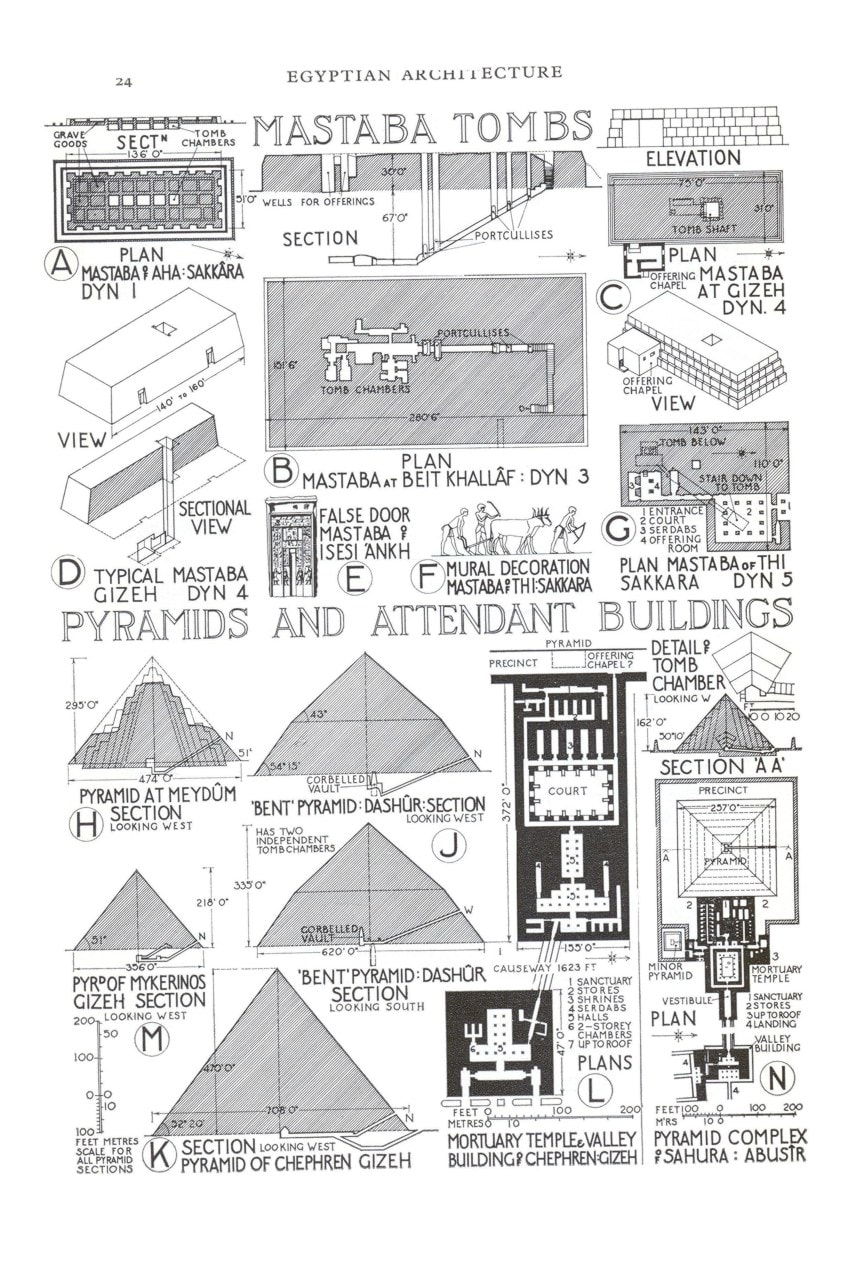 Examples of Mastaba Tombs; Sir Banister Fletcher (1866-1953), Public domain, via Wikimedia Commons
Examples of Mastaba Tombs; Sir Banister Fletcher (1866-1953), Public domain, via Wikimedia Commons
A major concern when building a tomb was the ability to penetrate laterally. To safeguard the structure's base from impairment, brickwork layers were built effectually it. The ancient empire'southward mastabas were erected in the shape of a pyramid. This method of burial was primarily reserved for rulers, such every bit the monarch and his family unit.
Other characteristics of mastabas from the old empire include rectangular forms, sloping stone and brick walls, and a building axis that runs both due north and south. The inside of the mastabas is divided into many sections, including an offering surface area, memorial sculptures, and a vault beneath which sarcophagi were kept. These burials were no longer used by the fourth dimension Empire ended
Gardens
Temple gardens, private gardens, and food gardens are the iii types of gardens that have been documented in ancient Arab republic of egypt. Some temples, similar those at Deir el-Bahri, included groves and trees, including the holy Ished Tree (Persea). Private pleasure gardens may be seen in a Meketra tomb model from the 11th Dynasty and in New Kingdom tomb ornamentation.
They were usually encircled past a high wall, with trees and flowers planted and shaded spaces provided. Plants were grown for their fruit and scent.
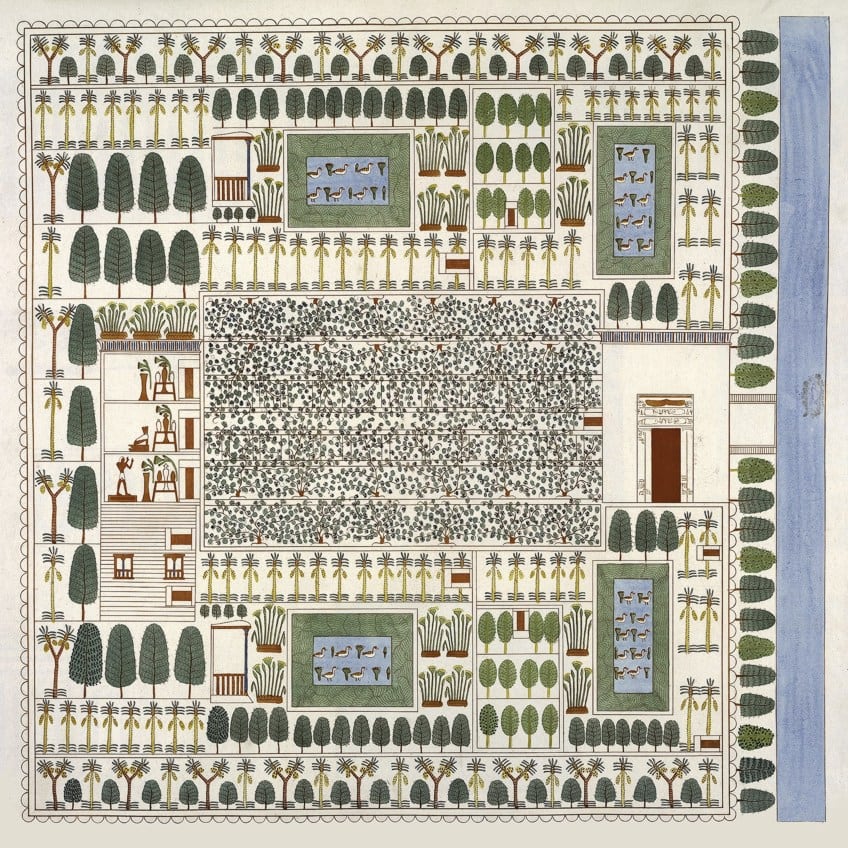 Ancient Egyptian garden of Sennefer;Gmihail at Serbian Wikipedia, Public domain, via Wikimedia Commons
Ancient Egyptian garden of Sennefer;Gmihail at Serbian Wikipedia, Public domain, via Wikimedia Commons
Cornflowers, poppies, and daisies were common flowers, while the pomegranate, which was kickoff cultivated in the New Kingdom, chop-chop became a dearest shrub. In the estate grounds of the well-to-do, a decorative pool was used to keep fish, ducks, and h2o lilies. Private or temple-owned vegetable plots were split into squares past water canals and placed about the Nile. They were watered either past paw or, starting in the tardily 18th Dynasty, by the shaduf.
Today nosotros have learned nearly the fascinating world of aboriginal Egyptian architecture. The history of aboriginal Egypt was not one of a unmarried, long-lasting culture, merely i marked past instability after upheaval. Scholars have separate the history of the region into several periods. Egyptian architecture is no exception. Instead of a single style, there were a variety of styles that emerged over different historical periods merely shared some traits.
Frequently Asked Questions:
What Were Pyramid Buildings and Egyptian Buildings Made From?
Because wood was scarce in ancient Arab republic of egypt, the virtually prevalent construction material was baked mud and rock brick. Granite and sandstone, as well as limestone, were prominent building materials. Bricks were ordinarily employed for town and fortification structures, whereas stone was reserved mostly for temples and cemeteries. Local quarries and gravel, sand, and mud bricks were used to construct the pyramid structures' interior.
What Are the Most Well-Known Buildings of Egyptian Architecture?
The Egyptian buildings of the Giza complex are the most famous example of Egyptian architecture. They are iconic symbols of a long-gone era of Pharaohs. The pyramids and the Great Sphinx are specially recognized around the earth as ancient wonders that nevertheless deserve to be admired and explored. The magnificence and wonder of these huge Egyptian monuments still stir the imaginations of scholars and the public.
Source: https://artincontext.org/egyptian-architecture/
0 Response to "What Was the Art and Architechture in Ancient Egypt Like Pre 1500"
Postar um comentário